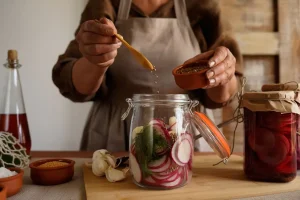How to Furnish a Tiny Home – Space-Saving Tips and Tricks

Making a small home interior nice and cozy requires you to use your creativity and come up with clever design choices as well as buying multifunction furniture that should add more function in the space.
Lofts are raised beds that leave space underneath, which can be used for seating or storage areas, while wall-mounted nightstands might save even more floor room space.
Corner sink and toilet combinations free up space in the bathroom, creating the illusion of a larger room, and recessed medicine cabinets keep your necessities at the ready without taking up valuable real estate.
Paint the Walls
And if your tiny home is a mess, perhaps it’s time to hang things on the walls, where there are plenty of options online, from drawer organisers to French cleats.
Walls should be white because this will make rooms look larger and brighter, and if you have windows it will reflect daylight into the hallway, brightening your tiny house. Dark colours can make spaces appear smaller.
One of the key features to give your tiny home a more lived-in feel is to maximise the amount of light you create. Build shelves or cubby holes around windows, or use translucent partitions to create walls, allowing light in while still giving privacy, as well as enabling you to see what you are doing!
Hanging Decorative Pieces
Decorative pieces are a great way to brighten up small accommodation while using minimal space and creating the impression of a bigger room. Go for monochromatic colours for the best results and the illusion of both simplicity and spaciousness.
Sky lights will help to dwarf you small house by making it look larger, via allowing the sunlicht in during the day and soft light at night.
Additionally, small homes provide no opportunity to acquire items that we do not know how to make use of. in small homes, storage solutions must very often be ingenious. Look under seats for storage, in corners, above cupboards… A lot of extra storage can also be provided behind bathroom doors with shoe racks and towel hooks.
Upgrading your kitchen with pull-out pantry ideas will help save space in your area. With narrow racks storing cans and jars, as well as other containers that are slim in width, this option offers better utilisation of space when compared to shelves blocking and occupying cupboard spaces with clutter. At the same time, your kitchen remains clean and tidy – with cupboard space utilised for essentials.
Use Wooden Floors
Small rooms, especially those without much natural light, can be constrictive, even claustrophobic. But light wood floors help open up a space, making it look larger by reflecting natural light to the windows and drawing the eye there.
Panelling (reclaimed wood), laminate and vinyl flooring are also good options; the latter two are easy to clean too. If you have a cosy abode and aren’t a meticulous germaphobe, bring in the good stuff. 5. Treat it as a final destination or layover If your apartment is cramped, the last thing you want is to put it on the market at the end of less than two years. Decide if you want your ‘Home Smart, Home Small’ residence to be a final destination or a layover – somewhere you’ll be for at least three years before moving on to a bigger home, or perhaps your dream house.
A portable wall-mounted table with a foldable table top might be a great space-saving investment, especially if it folds away out of sight when not needed – a good way to use vertical space and free up more floor space. Lofted beds, futons that fold up into walls or into other multiuse pieces of furniture may also be good options; finding multiuse furniture that suits your tiny house will work well in other spaces when you move house if you find a bigger place to live in.
Get Miniature Items
Using miniature accoutrements in the tiny home is a powerful way of adding design features. Vases, lamps and decorative objects can be purchased secondhand or online. Moreover, with varying light sources (such as sunlight through a nearby window that can cast intricate sparkles against a vase), miniatures can add beautiful accents of texture that bring out depth.
Every small homeowner needs room to not only store items but live, and adding shelves and hooks to your walls are just two examples of how you can free up space while applying solutions that can add a touch of decorum while keeping everything in place. They are also great for those who lack cabinet space around the bathroom or kitchen: over-the-door organisers hold all the hand and body products one can possibly need for many more months than you might expect.
Shelves in corners of your small house is a great way to display books and paintings – perfect solution when building shelves in the hallway corners.







